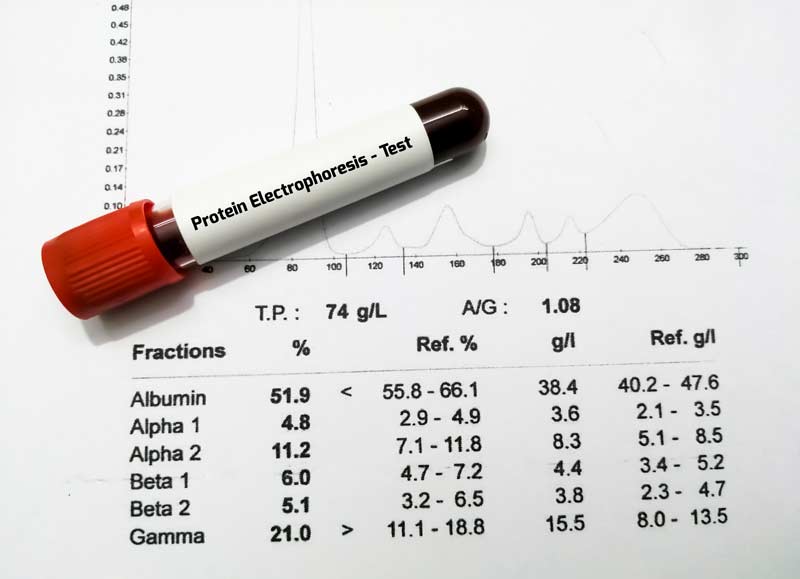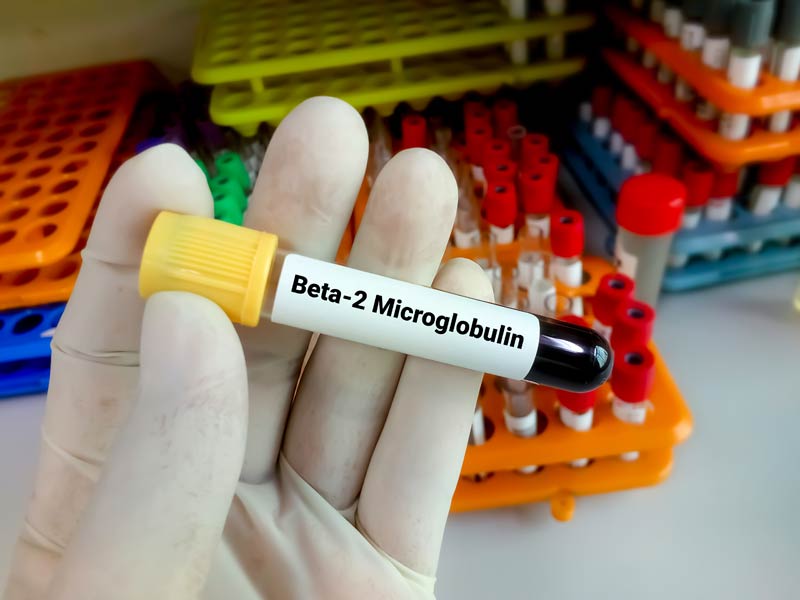Sokal Index for Chronic Myelogenous Leukemia (CML)

Index Sokal predicts survival of CML based on clinical and lab information.
NB! Based on Index Sokal can be assessed to predict prognosis at the time of CML diagnosis, before starting treatment.
Maximum distance palpable below costal margin:
Cm
Inches
10⁹/L
10³/µL
| Patient’s Sokal Score | Risk Group | 2-year Survival | Median Survival |
|---|---|---|---|
| 0 | 0 | 0 | 0 |
FORMULA:
Sokal Score = exp([0.0116 × (age in years – 43.4)]) + [0.0345 × (spleen size in cm – 7.51)] + [0.188 x ((platelets in 109/L / 700)2 – 0.563)] + [0.0887 × (blasts in % – 2.10)]
The Sokal Index, also referred to as the Sokal Score, was developed for using patients treated in the pre-tyrosine kinase inhibitor era and thus can not necessarily be applied today. Survival outcomes have dramatically improved since that time.
The original derivation study included 813 European and American patients treated before imatinib was available. The validation study was done during the era of interferon treatment and showed that, even then, the Sokal Score was no longer predictive, and the Hasford Score was a better predictor of survival. Outcomes have significantly improved after the use of imatinib and led to the development of a new score called the EUTOS Score.
There are two major studies (Uz 2013, Yahng 2012) suggesting the EUTOS Score outperforms the Sokal Score and one study (Marin 2011) showing the converse.
Although scores are stratified into low, intermediate, and high risk, some studies demonstrated that low and intermediate risk have similar outcomes.
Some experts advocate combining the Sokal and EUTOS Scores for better predictive value assessment.
The Sokal Score can be used to determine risk and decide on therapy based on the NCCN guidelines for CML. While the EUTOS score is easier to calculate and more accurately identifies high risk patients in the era of tyrosine kinase inhibitors, it has not been adopted by the NCCN guidelines.
NCCN guidelines for CML treatment recommend use of the Sokal Index and Hasford Scores over EUTOS for clinical risk stratification.
Although The Sokal Score is also preferentially used in clinical trials so that comparisons can be made to prior trials.
NOTE! Can only be applied in a newly-diagnosed patient prior to starting therapy.
Interpretation:
| Risk Group | Sokal Score | 2-year Survival | Median Survival |
| Low | <0.8 | 90% | 5 years |
| Intermediate | 0.8–1.2 | 65-90% | 2.5-5 years |
| High | >1.2 | 65% | 2.5 years |
The cytogenetic and molecular response is more predictive of outcome once therapy is started in patients with CML.
Although the Sokal Score has limited usefulness outside of clinical trials today, in general, low and intermediate risk patients can be started on standard dose imatinib, and high risk patients should be considered for newer generation TKIs or be monitored more closely to ensure complete molecular response.
Literature:
Sokal JE, Cox EB, Baccarani M, Tura S, Gomez GA, Robertson JE et al. Prognostic discrimination in “good-risk” chronic granulocytic leukemia. Blood 1984; 63: 789-99. https://pubmed.ncbi.nlm.nih.gov/6584184/
Thomas M, Irving J, Lennard A, Proctor S, Taylor P. Validation of the Hasford score in a demographic study in chronic granulocytic leukaemia. Journal of Clinical Pathology. 2001;54(6):491-493. doi:10.1136/jcp.54.6.491. https://www.ncbi.nlm.nih.gov/pmc/articles/PMC1731441/pdf/v054p00491.pdf
Uz B, Buyukasik Y, Atay H, et al. EUTOS CML prognostic scoring system predicts ELN-based ‘event-free survival’ better than Euro/Hasford and Sokal systems in CML patients receiving front-line imatinib mesylate. Hematology. 2013;18(5):247-52. https://pubmed.ncbi.nlm.nih.gov/23540886/
Yahng SA, Jang EJ, Choi SY, et al. Comparison of Sokal, Hasford and EUTOS scores in terms of long-term treatment outcome according to the risks in each prognostic model: a single center data analyzed in 255 early chronic phase chronic myeloid leukemia patients treated with frontline imatinib mesylate. Blood 2012;120:Abstract 2794.
Marin D, Ibrahim AR, Goldman JM. European Treatment and Outcome Study (EUTOS) score for chronic myeloid leukemia still requires more confirmation. J Clin Oncol 2011;29:3944–5. https://ascopubs.org/doi/full/10.1200/jco.2011.37.6962
Yamamoto E, Fujisawa S, Hagihara M, et al. European Treatment and Outcome Study score does not predict imatinib treatment response and outcome in chronic myeloid leukemia patients. Cancer Sci. 2014;105(1):105-9. https://pubmed.ncbi.nlm.nih.gov/24450386/
Pfirrmann M, Baccarani M, Saussele S, et al. Prognosis of long-term survival considering disease-specific death in patients with chronic myeloid leukemia. Leukemia. 2016;30(1):48-56. https://pubmed.ncbi.nlm.nih.gov/26416462/
Complete the associated clinical case simulation:
Register on our website right now to have access to more learning materials!
Baseline Cardiovascular Risk Assessment in Cancer Patients Scheduled to Receive Cardiotoxic Cancer Therapies (Anthracycline Chemotherapy) – Online Calculator
Baseline cardiovascular risk assessment in cancer patients scheduled to receive cardiotoxic cancer therapies (Anthracycline Chemotherapy)…
National Institutes of Health Stroke Scale (NIHSS) – Online calculator
The National Institutes of Health Stroke Scale (NIHSS) is a scale designed to assess the…
Charlson Comorbidity Index (CCI) Online Calculator
Charlson Comorbidity Index predicts 10-year survival in patients with multiple comorbidities.
Multiple Myeloma Diagnostic Criteria – Online Calculator
Revised Multiple Myeloma International Staging System (R-ISS) Online Calculator
Revised Multiple Myeloma International Staging System (R-ISS) – prognostication tool for myeloma patients based on…
Multiple Myeloma International Staging System (ISS) Online Calculator
Multiple Myeloma International Staging System (ISS) prognosticates the severity of multiple myeloma based on routinely…











